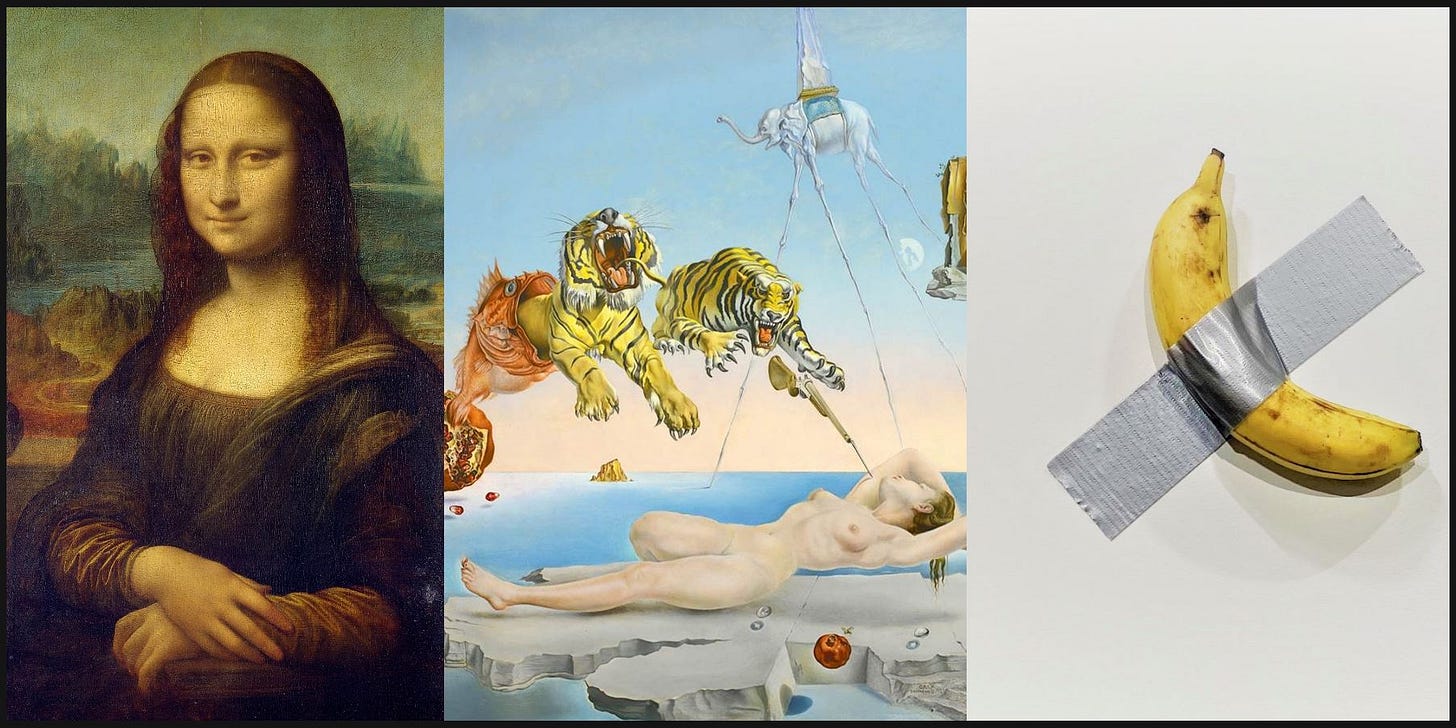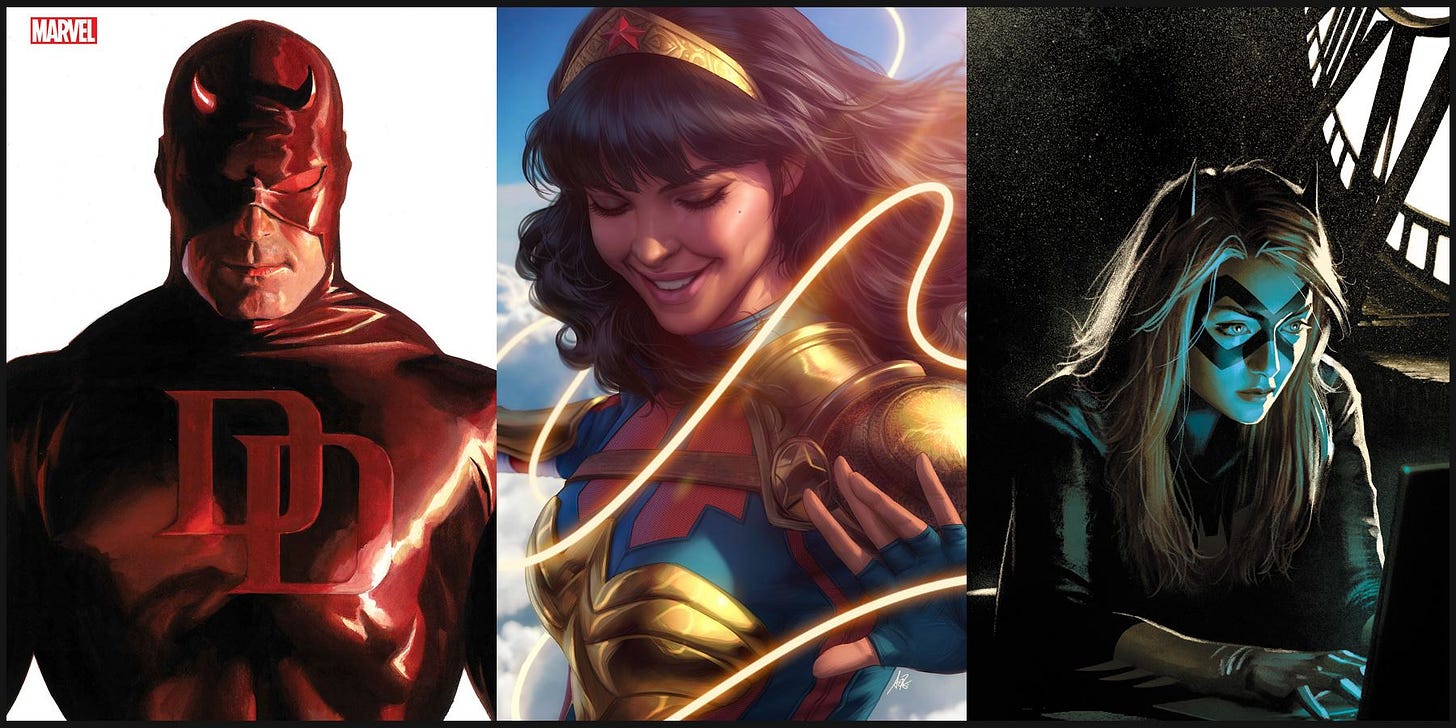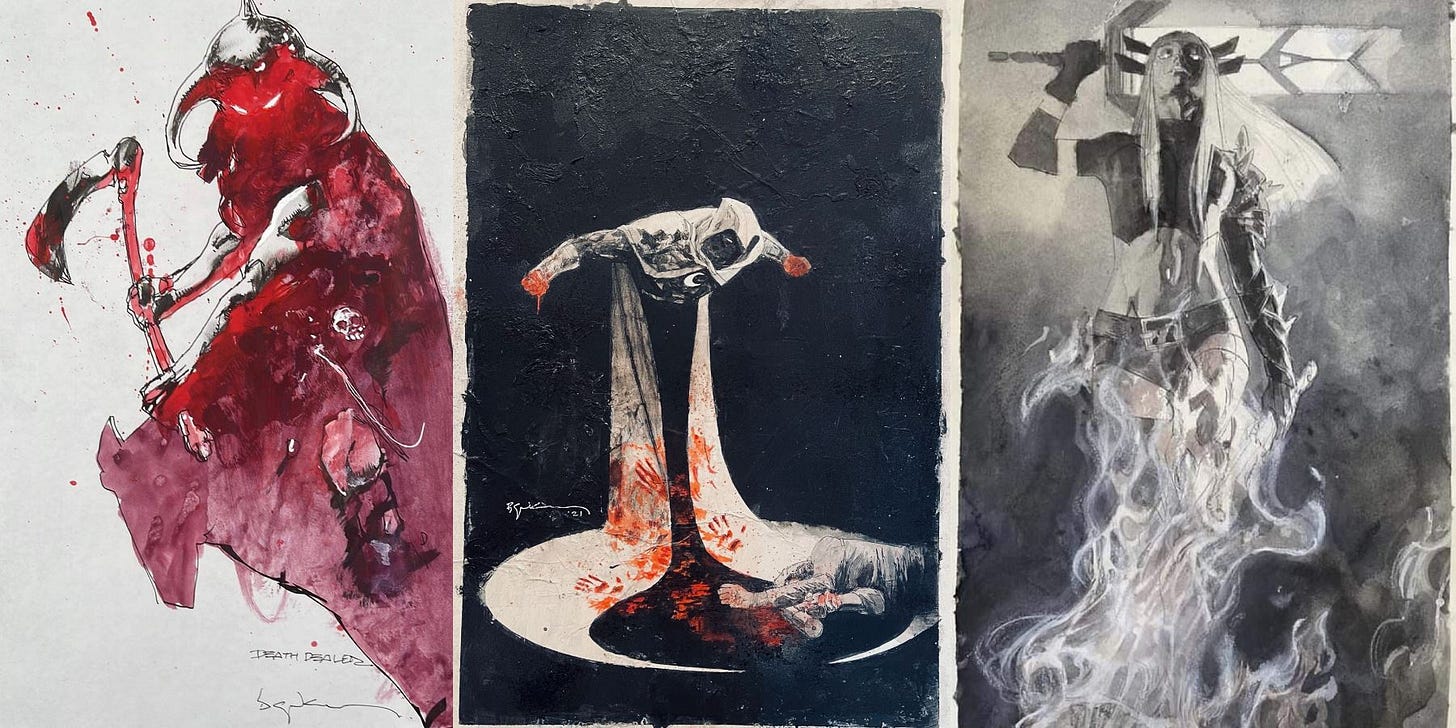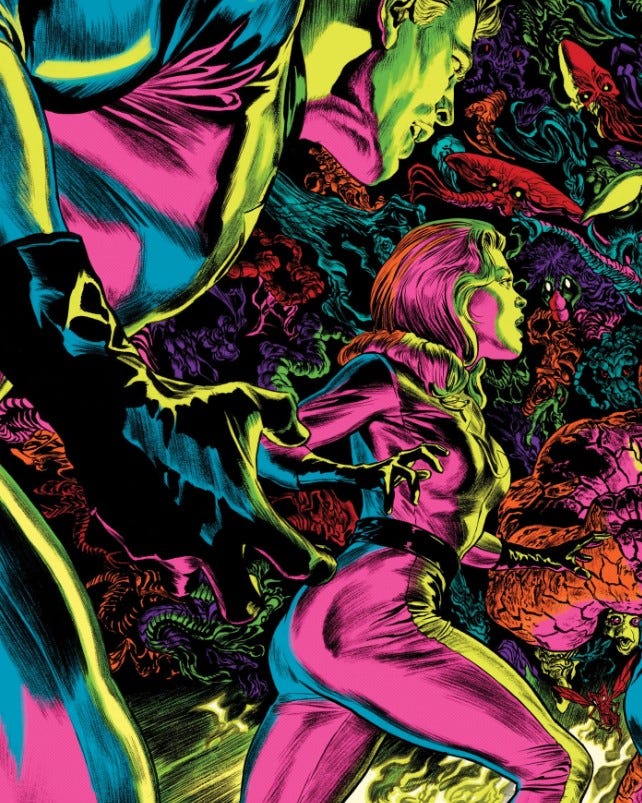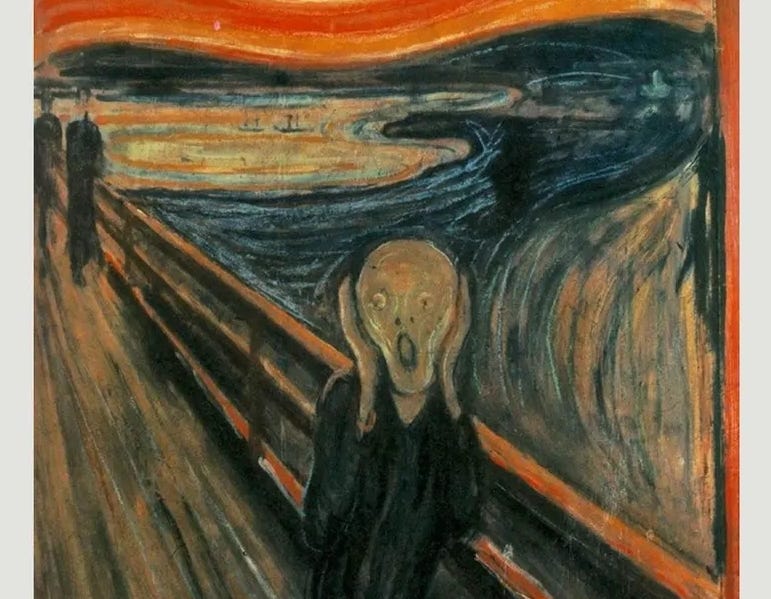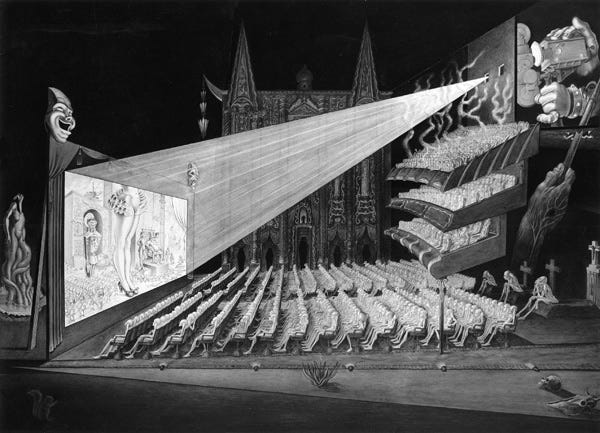Art. What is it and what's the point?
Is making art just a self stimulatory behavior? also Mumpworld #008
What is the purpose of “art”? Is it’s only value to be a distraction or aesthetically pleasing? Let’s discuss it.
(This post may be too long for your email, so view it on substack if it is cut off for you)
Of course, first here is the next episode of Mumpworld (#008)
What are we going to do with that crazy little alien?
Oh well, on to our main topic
What is Art?
A simple definition offered by Mirriam-Webster is “the conscious use of skill and creative imagination especially in the production of aesthetic objects” and “works so produced” (mirriam-webster.com). This seems to imply that the objects themselves only serve the purpose of being “aesthetic”, or in some degree adhering to standards of beauty and/or taste.
I feel that I must give a disclaimer to this whole discussion. I am not an art historian or philosopher. I have not formally studied “art” in that way. I am a healthcare professional trained to assess, and treat physical and mental health concerns and to read, interpret and understand scientific literature. I am also a creator, a “maker” and an abstract, outside of the box thinker. I am influenced, but not bound by social norms and mores. Hopefully what I share in this newsletter will encourage you to explore your thoughts on these topics, but I won’t tell you what to think (mostly).
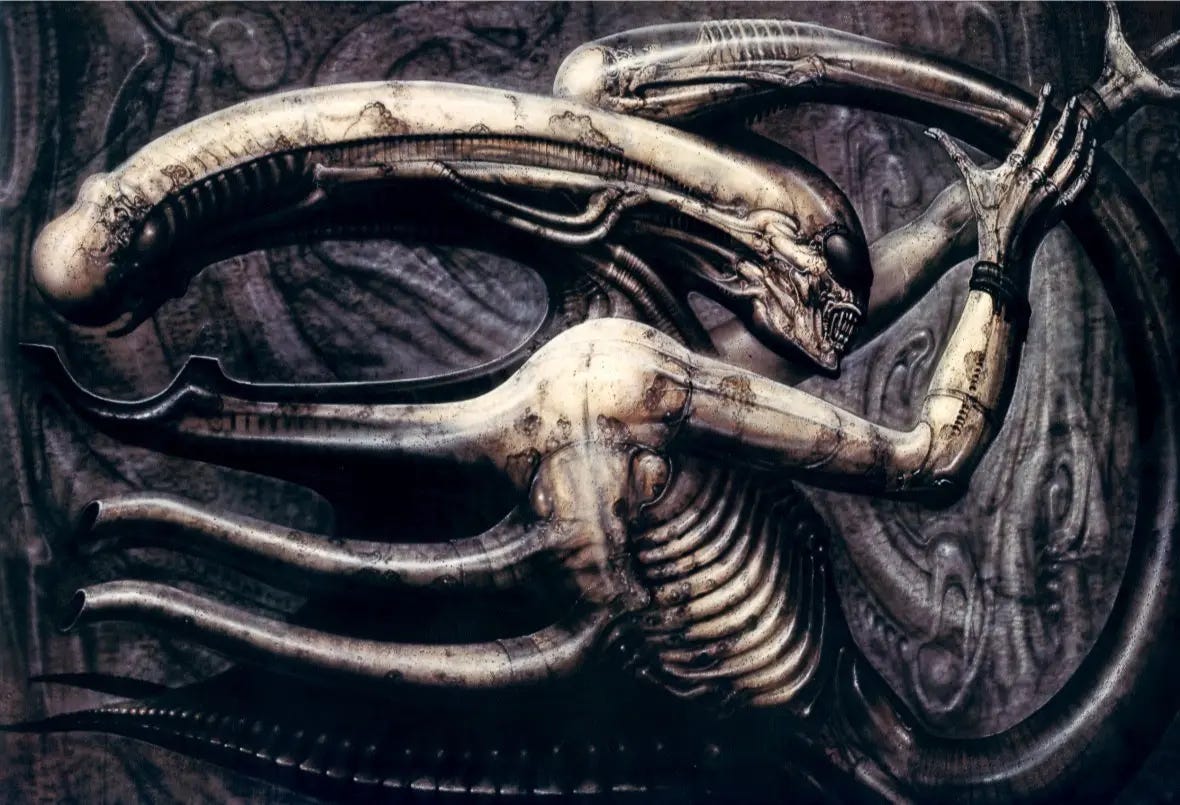
The above definition of art feels rather unsatisfying to me. There is of course whole books and a litany of articles discussing philosophically what the true definition of art is, in some cases arguing that it cannot be defined. Although I often find criticism and interpretation of artworks to be somewhat self indulgent, art, in my mind, is much more than simply “aesthetic” objects. Art has a deeper value and can serve a variety of purposes. Some art, particularly visual arts, can transcend language and connect with people in a visceral and emotional way that is both moving and thought provoking. Artists I have spoken to and read about, both classically trained and self taught, have expressed strong desires to communicate with their audience. Many express the idea that the final art work is only complete when it is viewed by someone who takes the time to appreciate and interpret it from their personal perspective such as Marcel Duchamp. (Love them or hate them his 18 most puzzling works had a significant impact on the art world).
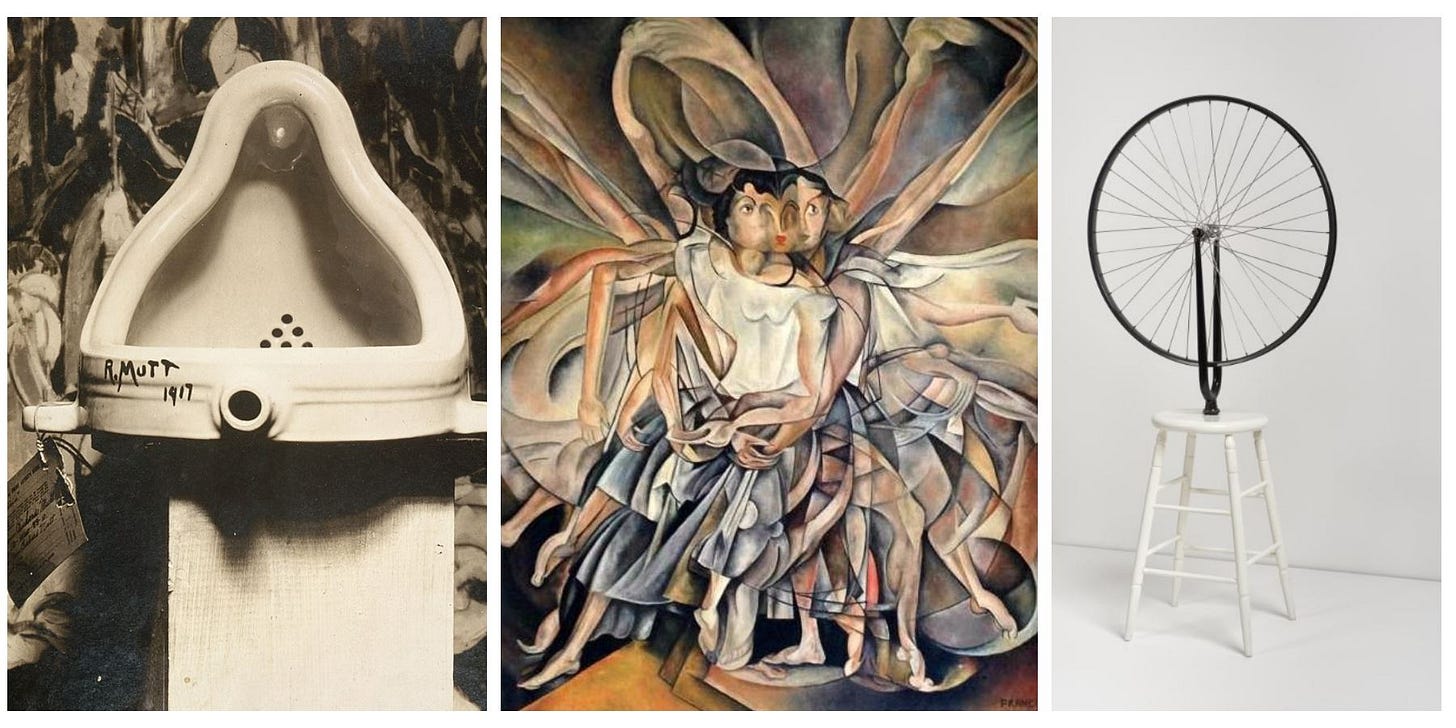
In Duchamp’s case, he “wanted to distance himself from traditional modes of painting in an effort to emphasize the conceptual value of a work of art, seducing the viewer through irony and verbal witticisms rather than relying on technical or aesthetic appeal” (see here for a more in-depth description of his career). In this light, the experience of viewing a piece of visual art, the emotions it evokes and the thoughts or ideas that it promotes are all part of the relationship between artist and audience and contribute to the ultimate meaning of the work. Music, for me, can be experienced in much the same way. Even when lyrics are poetic and almost nonsensical, they can elicit emotion and that can be a deeper form of communication than a literal interpretation may be. All of this, of course is simply my opinion.
Are Comic Books, Graphic Novels and Children’s Books “Art”?
Yes they are, just accept it.
(Is that “indoctrination”? See my last post for some thoughts on that.)
In the comic world, there are many views about the nature of the work and the business. Some argue that comics are just entertainment, an escapist activity and a business whose sole purpose is to make a profit. they would argue that their work has no “agenda” and is purely meant to be enjoyed as a distraction from the everyday. Others would argue that comics are a form of art that combines visual communication with literature to create a unique and powerful medium for promoting reflection on assumed norms and values. In my experience, this dichotomy is evident even in the visual styles used. At the extreme end, political cartoonists, while they have remarkable skill in what they do, make no effort to draw realistically. In fact they use stylistic exaggeration for communicative effect. At the other end of the spectrum, there are many amazingly skilled artists creating remarkable images in a photo-realistic style. I have no quarrel with either of these types of artists. In fact, I quite admire their skill in many instances, but I often find that the more realistic the work becomes, the less “life” it seems to have.
The best examples I can give, come from the comic world of course. Those who really appreciate realistic drawings (often used for covers) can find them from artists such as Alex Ross (see his current take on the Fantastic 4 here), Stanley Lau and Joshua Middleton.
Such artists seem to be following in the footsteps of some of the most skilled movie poster artists of the past whose job it was to create a fantastic image with real actors likenesses. I personally find myself drawn to art works that are more raw and somewhat abstract. I think this is because the more abstract images invite the viewer to contribute to the meaning and can be viscerally very powerful. I have always been fascinated by the abstract, stylized or cartoonish work of artists such as Bill Sienkiewicz (pronounced Sin-kev-itch),
Hellboy creator Mike Mignola and Frank Miller (Creator of iconic series such as Ronin, 300 and Sin City).
Honestly, this is entirely my subjective opinion. The more stylized work just feels more enticing to me. If I had to describe it, I think that the artists who are deviating from realism, have more opportunity to play with colour and shape and focus to establish mood. I’m sure there are remarkable realistic artists out there that can also create a strong sense of mood in their work, but it seems to me that they would be fighting their own style to do so.
Even considering a visual medium such as film, it is important to note that the lighting is often entirely unrealistic. It is used strategically to assist the producer to set the tone of a sequence and that has a lot to do with establishing a mood.
Looking at Alex Ross’s current Fantastic 4 comic, we can see a nice balance of realism in the proportions and details of the characters, but some creative lighting and colour to create a mood that is exciting and dynamic.
Artists throughout history have made choices in their work to enhance a particular aspect of the subject, and draw attention away from other areas. Even in portrait painting, the artist decides where the viewer’s eyes are drawn. The artist creatively enhances those features that are either visually pleasing, or that contribute to the over-all mood being established. In comic art, animation and even portrait painting, subtle shifts in posture or pose of the subject can drastically change the mood. Often when drawing a character myself, I find that the initial drawings just don’t live up to the idea that I am conceptualizing. After several iterations, it is often the posture of the character that needs to be pushed beyond what would be “realistic” in order to truly express the feeling that I was trying to capture.
That’s great and all, but you really only discussed “Aesthetics” so far
Yes. You caught me. Sort of.
The reason I keep bringing up “mood” in the discussion of aesthetics, is because I feel like this is where the artist straddles a line. If an artist has a personal experience that effects them profoundly enough to motivate them to create, it is likely that other people have had similar experiences. That feeling of emotional connectedness, that recognition of base emotion is what drives the popularity of classic images such as Edvard Munch’s “The Scream”.
Regardless of whether you know the specific circumstances that led to it’s creation, most people can relate to the feeling evoked by this image. Munch’s “The Scream” is the second most famous piece of artwork behind Leonardo Davinci’s Mona Lisa.
Most people who view “The Scream”, do not have a direct, black and white, concrete explanation of its “meaning”. They do however connect with the feeling expressed by the painting, and I think ultimately that is the point. You are not alone in feeling this way.
Other artistic works, notably science fiction literature, have historically served the purpose of expressing concerns about the future of human existence when considering a specific set of existing conditions. This, arguably, is the whole point of dystopian fiction. Unfortunately, many people seem to view dystopian sci-fi as a simple heroic fantasy. They see the dystopian setting as an almost meaningless backdrop to a simplified struggle between good and evil. Zombie films come to mind in this regard. When faced with the complexities of human existence in the Western world currently, for some people, the idea of solving all of your problems by shooting them in the head seems somehow less stressful.
The remarkable thing about art, is that when it is executed with passion and skill, it can reach people on a level that is deeper than conscious thought. Unfortunately the film industry struggles to have that deeper impact. Prose is certainly a better vehicle to expose people to a variety of ideas and thoughts, but many do not make the time to access it.
There has long been disagreement about the purpose and nature of art. If art is simply aesthetic, then it doesn’t have any deeper meaning. It can’t really be an instrument for provoking thought. It is simply a distraction. I find it hard to look at works such as Munch’s, Dali’s or Seinkewicz’s and say that there is no deeper meaning. If art is a vehicle for promoting thought, for encouraging people to question the status quo or to explore alternative ways of thinking and being, then it’s importance to human kind is immeasurable. I choose to believe in the latter. This leads me to a significant concerns that I have with the current entertainment industry. My concern is that most people who are in the business of creating this “art” (which they now refer to as “content”) do not believe it has any deeper meaning. The only meaning it has to them is the profit that it can make for them. Unfortunately, whether they believe it or not, their content is shaping the minds, beliefs and attitudes of their “consumers”. Whether they realize it or not, they too have an “agenda”.
You recall how I mentioned what I thought was the intention of traditional dystopian sci-fi? Well if you ignore that prophetic intention, which was designed to make people think about their current choices and hopefully make positive changes in the world. What you are left with is that simplistic heroic fantasy that the industry will say is just “escapism”. What lesson is this “escapism” actually teaching to people, especially young people? That every problem can be solved through the application of threats, or violence. What kind of a world would you expect to see if that is the foundation of the culture? I suspect it would be a very self centered, intolerant and divided one.
Just sayin’
Final Thoughts
Personally, I appreciate artwork that combines visual appeal and deeper meaning. The meaning does not have to be rigidly or concretely “spelled out” for the audience and in fact I think is less compelling when it is. Nobody wants to be “preached at”. Establishing mood, giving hints of an underlying message, but leaving the viewer of the work to contribute to the meaning is, in my opinion, the most satisfying form of “Art”. This may mean that some people walk away from an artists work with an entirely different interpretation than the artist intended, but that is the “spice of life”. It is the job of the artist to communicate. The artist can encourage the viewer of their work to consider ideas in a way that they otherwise might not have, but inevitably the world is made up of many different types of people. When we can all come together with some common decency and respect, those different perspectives can make us all better in the end. It is easy for people on all sides of any issue to develop blinders to any other perspective and thereby miss reasonable solutions.
I am always striving to be as open minded as possible, without becoming completely opinion less.
Afterword
In exploring this topic, I also had many thoughts about the current concerns with Artificial Intelligence (AI) in the art community. For those of you who don’t spend all your free time scrolling youtube and instagram art channels, AI systems are being used to create some visually interesting images, often in the slightly abstract style that I appreciate from human artists. Many people in the online art community are concerned about this and worry that it will mean an end to human created art. I feel like this is a topic that requires it’s own full newsletter and hope to tackle that in the near future, so stay tuned.
I hope you found exploration of art somewhat interesting, please share your thoughts in the comments.
Come back for more random thoughts, and I’ll see you next time.
blackManic






